Thanks to all who participated in our shoot-out! Last week, I posted three recordings of a weak shortwave broadcast in an attempt to evaluate which recording–thus which radio–our listeners prefer. The test was “blind” in that, though four radios were evaluated, only three recordings were posted, merely labeled, “Sample #1,” “Sample #2,” and “Sample #3,” respectively.
The radios tested were not just average radios. Rather, they represent the best of the truly portable radios currently on the market, namely: the Sangean ATS-909X, the Tecsun PL-880, the Tecsun-PL660 and the Sony ICF-SW7600GR.
Indeed, the most popular question I receive from SWLing Post readers is about two or more of these models, asking,”which is best?”
The samples
To refresh your memory, I’ve embedded the audio samples below–but if you haven’t yet, I would encourage you to read our previous post (and the great reader comments following!) before proceeding.
The recordings in our samples are of Radio Romania International on 11,975 kHz. Normally, the signal would have been stronger, but propagation was rough, and QSB (fading) was pronounced at times. Note that I recorded all of these samples with my Zoom H2N digital recorder via a line-in connection, using the radio’s headphone jack. Since not all of the radios have a line-out jack, I used the headphone jack each time and simply set the volume and line-in gain to the same level.
And now, here is the sample I intentionally left out in my previous post…Sample #4. I didn’t include it in the evaluation because, frankly, it was such a weak performer compared with the other three; I knew it would take last place:
With that in mind, we’ll start with the radio behind Sample 4:
Sangean ATS-909X ($200-250 US)
Many readers guessed rightly that the Sangean ATS-909X was the radio omitted. Evidently, it is known for its lack of sensitivity when only employing its telescoping whip antenna. You’ll notice that, most of the time, the RRI broadcast is lost in the static.
Frankly, I was somewhat surprised that the ATS-909X didn’t perform better. It has a loyal following amongst SWLing Post readers and has been a popular radio on the market for the past three years or so. While I’ve used the ATS-909X in the past, I have never owned one, and had never done a side-by-side comparison.
To perform this test, I borrowed the 909X from a friend who usually has it hooked up to an external antenna. In fact, this is when I learned that the 909X performs admirably when hooked up to an external antenna.
In my tests, however, I didn’t want to hook up external antennas. I believe that for a radio to be evaluated as a portable, it must be judged on its ability to receive signals from its telescopic whip antenna as a base line.
But let’s move on to the radios you did hear in our weak signal evaluation…
Let’s take a look at the radio behind Sample #3, the radio our readers voted to take last place in terms of weak-signal listening:
Tecsun PL-880: Sample 3 ($150-160 US)
With the exception of three votes (out of more than seventy), Sample #3–the Tecsun PL-880–was overwhelmingly voted worst in this weak-signal shoot-out.
The bulk of your criticisms focused on the fact that the PL-880 did not handle fading as well as the other radios. When the signal was at a peak, it sounded great, but in QSB troughs, the signal became unintelligible and you could hear DSP artifacts and distortion.
But is the PL-880 a “bad” radio? Absolutely not. Indeed, I gave it pretty high marks when I reviewed it last year. It’s just not the best choice for weak-signal listening–at least in its current firmware version. Note to Tecsun: I do believe it may be possible to tweak this portable’s AGC circuit so that it handles fading better…
But let’s move on to the other contestants. Here’s our second-place portable:
Tecsun PL-660: Sample 2 ($110-130 US)
During the first day of voting, the Tecsun PL-660 actually had a noticeable lead on the other radios. I’m not surprised. The sensitivity was better than the rest of the contestants, in my opinion. The received audio was clear and seemed to pop out of the static better than the others.
Overwhelmingly, those who didn’t vote the PL-660 as best, voted it as second. Their main criticism was that the PL-660’s AGC was a little too active and less stable than the radio which actually took first place.
And with no further ado, here’s our winner:
Sony ICF-SW7600GR: Sample 1 ($130-150 US)
Surprised? I was!
After I evaluated the blind test myself, I was certain the PL-660 would be the winner with its stronger sensitivity. But the result–and reader comments–proved me wrong. More of you placed a value on the Sony’s rock-solid AGC circuit which handles the peaks and troughs of fading better than the other contenders.
Commenters noted that the Sony’s audio and stability lent itself to easier, less fatiguing, listening. Keep in mind, though, that many of these same commenters mentioned that the PL-660 (Sample #2) would be their preference for identifying a station in under weak signal conditions.
Now let’s look at the raw data, and then discuss what it all means.
The data
The Sony ICF-SW7600GR was voted:
- first place 41 times,
- second place 2o times, and
- third place once
The Tecsun PL-660 was voted:
- first place 23 times,
- second place 33 times, and
- third place twice
The Tecsun PL-880 was voted:
- first place never,
- second place three times, and
- third place 53 times
I’ve attempted to place this data into a bar graph to make it a little easier to visualize: 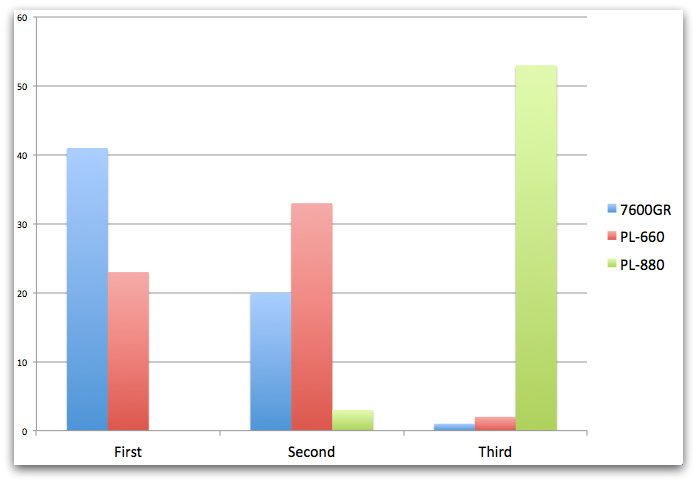 If you noticed that these numbers don’t completely add up, it’s because responses were inconsistent.
If you noticed that these numbers don’t completely add up, it’s because responses were inconsistent.
Most survey participants listed their preferences in order (i.e., first, second, and third place). Some respondents only listed their favorite of the three, while others only listed the one they didn’t like. No one responded with a tie between the radios, all had an opinion.
Another way of reading the results
SWLing Post reader “Radio Flynn” helped me with some additional data interpretation this morning. He put together this analysis (download as a PDF), and commented:
“[A]lthough a majority of people choose sample #1, nearly everyone ranked either sample #1 or sample #2 as preferred, and the average ranks are very close, closer than the raw percentages would indicate. I have not done a statistical analysis so I don’t know if the difference in mean rank between #1 and #2 is significant (in other words, I don’t know if there is a significant preference for #1), but you can say that either sample 1 or sample 2 would be acceptable to almost everyone, and sample 3 clearly last choice.”
Radio Flynn also pointed out that next time I do this sort of test (and I will be doing another!) that I should keep votes consistent by asking everyone to rank their preference. Excellent suggestion; I’ll be sure to do so.
So the Sony ICF-SW7600GR is the best radio…right?
Not exactly.
Herein lies the difficulty of suggesting the “best” radio for any particular listener.
This test only evaluated weak signal sensitivity under rather rough conditions. The Sony was “the winner” in this respect.
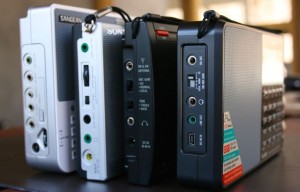 But this doesn’t tell the whole story.
But this doesn’t tell the whole story.
I’ve had my Sony ‘7600GR longer than any of the other portables in this contest and it is invariably the radio I reach for when I want to make a field recording. I prefer the Sony because it has good sensitivity, a stable AGC, excellent single-sideband selectable sync detection and it can handle being connected to a long external antenna. Indeed, it was the Sony I packed when I spent the summer of 2012 in an off-grid cabin in the Canadian maritimes. In short: my Sony ICF-SW7600GR is my “old faithful.”
But frankly, when I travel, I reach for the PL-660 more often than not. Why? Yes, the Sony has great receiver characteristics, but its ergonomics leave a lot to be desired. I use my Sony when I plan to key in a frequency and leave it there. The PL-660 is a joy to operate, has simple direct-frequency entry, an excellent auto-tune feature, not to mention, a stable sync detector.
If I want to identify a signal buried in the static, I reach for the PL-660.
If I want to do casual listening and am less concerned with DXing, I reach for the PL-880. It’s a solid radio and has a quality feel to it (running neck-and-neck with the ATS-909X in this respect). Of this bunch, it has by far, the best audio from its internal speaker. If I want armchair listening, I reach for the PL-880. It’s also an excellent SSB receiver–one of the best in this group–and offers more filter selections.
In summary, it’s not always easy to suggest which radio is best…I must ask in response, “Best for what?” The data from this test proves this, as our readers who ranked their favorites backed up their choices with consistent and valid comments.
What do you think?
Before long, I plan to pit these radios (and perhaps another?) against each other in terms of their synchronous detectors in another blind test. It may take a while to work this up. Your enthusiastic responses, however, completely justify it.
Stay tuned!
Resources:
- Sony ICF-SW7600GR
- On the SW Radio Index
- Retailers:
- Tecsun PL-660
- On the SW Radio Index
- Retailers:
- Tecsun PL-880
- On the SW Radio Index
- Retailers:
- Sangean ATS-909X
- On the SW Radio Index
- Retailers:

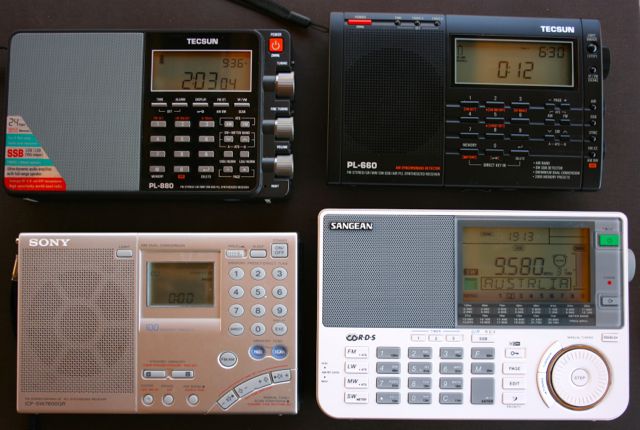
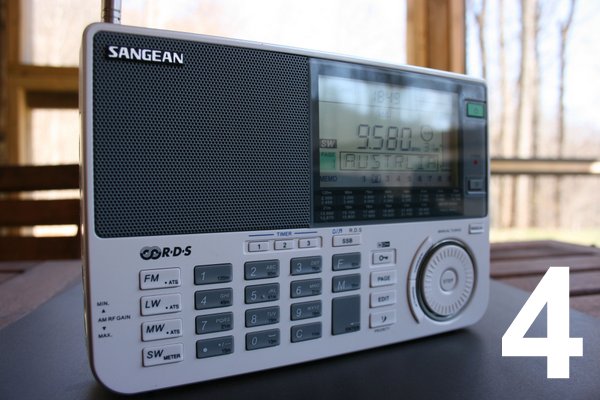
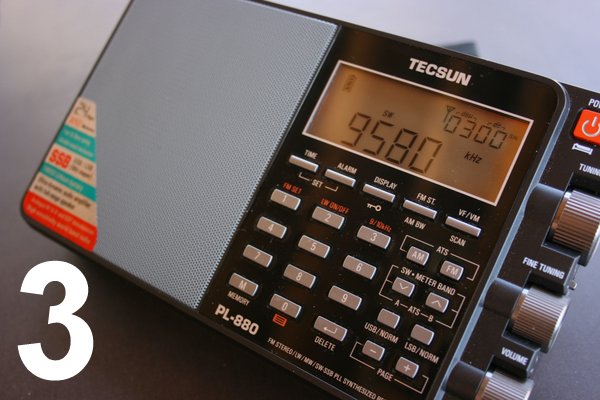
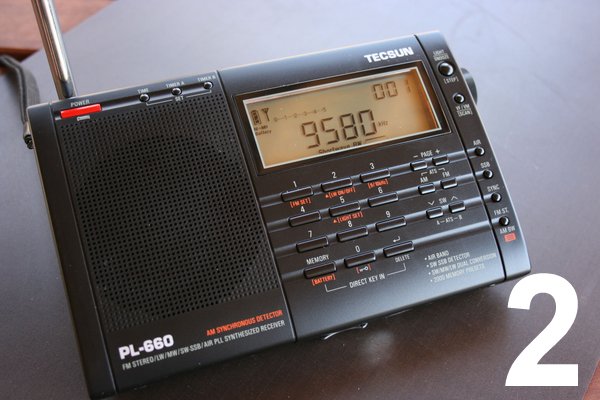
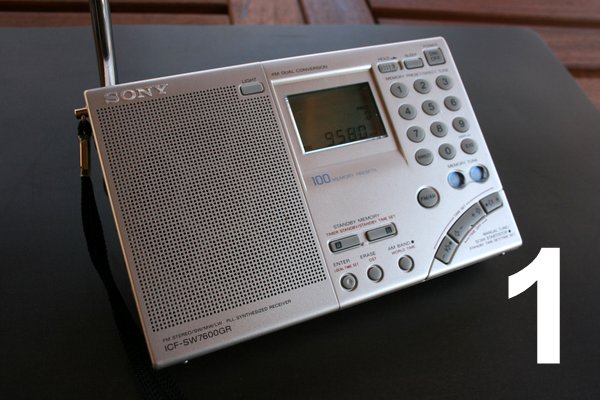
Let’s say that I would be surprised if someone told me on the spot the 7600GR peformed better compared to the remaining three. Not that it isn’t a good receiver. In fact, after acquiring and using several models of different brands, the 7600GR along with my 20 year old 7600G are still my reference receivers. For starters, they have best image rejection, very good AGC and the 7600GR is the only one with variable rf gain attenuator. So, after listening to these audio samples, I noticed audio sample #1 was from a receiver with the best performance. Then I proceeded and audio sample #2 was clearly a PL-660. Do you know why? I have one and I instantly recognized that hideous soft muting: the main reason why I rarely use it. Than #3 and #4 had to be PL-880 and ATS-909x not exactly in the same order according to inumerous reviews, some of them published here. Therefore, #1 had to be Sony ICF-7600GR. Its AGC handles qsb very well. My surprise is the quality of the audio. I consider the 7600GR’s audio too processed and after some time listening, specially with headphones I get exausted. You know what? I’m happy!
Although the radio has not been manufactured for at least a decade, the Sony ICF SW07 is still widely available new from Internet vendors, maybe that radio would worth testing.
Interesting, my Sony ICF SW7600GR unit is inferior to my Tecsun Pl-880 (Firmware Version 8820) in terms of weak signal sensitivity, could this be a result of product variation? I wouldn’t be surprised considering the universal lack in quality control in the Chinese electronics market.
i wish you could also test the Grundig G3, I have both it and the PL 660 and the G3 on weak signal Shortwave often outperforms the 660.
Really enjoy these audio shootouts.
Hi, David, I have a G3 here, but didn’t include it for two reasons: 1.) It’s no longer in production [I tried to stick with radios currently on the market] and 2.) the very final batches of G3’s that were sold had some technical issues. With that said, I am very tempted to pit the G3 against the PL-660 at some point. For a few years, the most popular question I received was, “which is better, the G3 or PL-660?” Could be fun. Stay tuned!
Very interesting results! Thanks for doing this. I’m looking forward to your next round of tests, and hope to see some DSP radios being evaluated.
Cheers!
Thank you for testing. Highly interesting.
Please could you tell which firmware version operates your PL-880…
I do not have the PL-660, but both my PL-600 and R9700DX TECSUN radios have an annoying hiss when there is silence between words or passages of music. Does the PL-660 have that as well?
The audio from my ICF-SW7600GR is thin sounding but almost all noise is filtered out so speech is very understandable.
I see there is a SONY ICF-SW7600GX shown on the SONY US website and by Google I see that model number listed in Eastern Europe.
Thanks so much for the kind compliments, you all.
Trust me, I had serious fun reading your excellent comments and watching the results roll in on the shoot out. I will certainly be doing this again soon. Frankly, as Radio Flynn stated, it’s a great way to actually crowd source a review and test a radio prior to owning it. The sound you heard when playing those recordings is the same sound I heard while testing them.
Tomorrow, I plan to put together a fun challenge and post it. Somthing I’ve been thinking about for a while. I hope all of you will join in the fun.
Again, many thanks and I’m glad you liked the blind test.
Best,
Thomas
Wow! That is a surprise. I was about to replace my 7600GR with a PL-880 so I could gain a tuning knob, that awesome DSP selectivity, great audio, and keep SSB. Guess I’ll wait and see what Tecsun does with it.
Fortunately, I still have my Panasonic RF-2200 that I bought back in the late 70’s. Great audio, excellent performance, and a nice big tuning knob 🙂 A little too bulky for travelling and way too drifty for good SSB performance though.
Mike: Or, in the meantime, grab a PL-660 too. The more radios, the more better! Right?
Cheers,
Thomas
Further to my earlier comments about the Sangean 909X and the Tecsun PL660, I largely use the internal antennas on both radios (which is usually more convenient for me). However, I tried both of them on their external antennas again today. It’s certainly true that the 909X’s sensitivity does improve on the external antenna – and, interestingly, I noticed on the PL660 that some stronger stations tended to overload the radio with the external antenna connected – not that it’s needed in those cases though.
One area in which I feel the Sangean really scores though is the layout of station memory “pages”, and it’s reception on FM/AM/LW. And it’s quite a good looking piece of kit too! What I guess it underlines is that it’s a good idea to have more than one shortwave radio, as each have their good and bad points – then you can hopefully have all bases covered!
Spot on! I love the Sangean display–that alpha numeric tagging sets the bar for others, in my opinion.
-Thomas
Another suggestion for a shootout or two: I’d also like to hear one that puts fringe daytime mediumwave (and maybe also longwave) signals up against each other, as well as being able to maintain relatively good audio fidelity (+/-2 kHz at -3 dB would be abysmal, 5 kHz would be ok, 9.95 kHz would be amazing I’m guessing) on a fringe mediumwave station sandwiched between two stronger signals +/- 10 kHz on either side, at least one of which is an ultra-strong local, with no splatter at all.
For example, I’m thinking the test station on the sensitivity test would be indicating 15 dBµ, 1 dB S/N on the PL-880 in its narrowest BW mode (or if the dBµ can read lower, than no more than 1 or 2 dB above the lowest it will register). The signal should be strong enough to be able to recognize the tune of a piece of music that may be playing, but too weak to be able to understand speech even if it’s in English. I’d also like to hear radios with other-sized antennas tested, so I can have an idea of how much difference there is between them – for example anything from a small antenna like an SRF-59 to a large antenna like a CCRadio / PR-D5 / etc, and smaller and larger.
For selectivity, take a similarly-weak station to the sensitivity test, next to a very strong local station whose dBµ on the PL-880 is up in the mid to upper 90s. (The station on the other side of the weak target should, if possible, be the higher of 52 dBµ, or 48 dBµ stronger than the target.)
Noted, Stephen! Thanks for the suggestions.
I plan to do a MW shoot out in the future that will mix day. fringe (greyline) and night conditions. In many ways MW is so much more complicated to set-up for a review, but it’s such a great way to evaluate performance and, especially, AGC characteristics.
Thanks,
Thomas
Great shootout. Thanks! Thoughts: Adding a 2010 and G3 to the mix sounds great. This last test was a “line out to recorder” test. It will be tougher It is tougher to demonstrate how the radio speakers sound … a decent recording microphone and attention to placement will affect how each radio’s speaker is perceived in a recording. Just the same, this test could satisfy curiosity about DX’ing using the radios speaker as opposed to ear buds. Also – curious if you would consider re-doing this last test and narrowing the 880 bandwidth to match that of the 660 & Sony? How does matching bandwidths affect perceived difference in sound? Wider bandwidth on the 880 means more high frequency ‘hash’ enters the audio spectrum so the 880 sounds weaker. But is it? Thanks again, Mark
Good points, Mark. I might just post some recordings sometime of the PL-880 as the bandwidth decreases. It has so many BW increments, it’s hardly fair to the bulk of the contenders who only have two. 🙂
Thanks for your comments!
-Thomas
I’m curious how the Grundig G3 would compare in a shootout with the other radios…
Benjamin, you’ll get your chance to hear when I compare sync detectors! The G3 will be in that bunch.
-Thomas
A great idea and I hope more like this are forthcoming.
Keep up the great work.
You’re most welcome!
Do the radios compare the same way on weak signals on the other bands too or is the result different if the comparison is based on a different band?
Very good question. By and large, yes, I found the radios to be fairly consistent across the bands. With that said, sensitivity on each radio does vary slightly going from the lower bands to the higher ones. I found, for example, that the 909X did a little better job on the lower bands at night (though still not on par with the others when only using the whip antenna).
-Thomas
Thomas, your idea of making a recording and letting your readers decide the winner is brilliant in its simplicity and objectivity. Every other radio review I can think of is either entirely or mostly subjective opinion, but you have found a way to eliminate biases and surprise us with the result. Thanks.
Many thanks to _you_ for your excellent analysis! I hope you’ll help me with future review data sets.
Best,
Thomas
Thank you Thomas for this interesting test.
I was suspecting that the Sangean was the one omitted, (but hoped it wasn’t). as had been said by others, radio out of the box should preform well with it’s antenna without the need to mess with it.
as I noted, i have messed with my 909 to get it going, as it was totaly deaf with it’s telescopic antenna (but exellent with external antenna), and now it preforms well with the telescopic antenna.
as for me, I would be interested comparing the 909X preformance in SSB mode (the capability of zero in on a signal, and how it will sound on different radios).
another thing is ergonomics, as you noted, the 7600GR lacks the tuning knob, and for me it is A serious con.
Well done, and all the best!
Moshe Z.
Moshe–thanks for the comments. I will post an SSB comparison of the same radios.
Cheers,
Thomas
I echo Christos and Ken Carr’s earlier comments – great idea Thomas. I’ve been waiting in anticipation all week for the results!
I own two of the radios in the experiment (the 909X and the PL660) so it was especially relevant to me. I was pleased that the 660 came second, but got caught out by the 4th placing of the 909X – perhaps I just didn’t want to admit what I perhaps already knew deep down?
I already owned the 909X when I bought the PL660, and it didn’t take long for my A/B comparisons with both, on the first day of owning the Tecsun, to make me realise the superiority of the latter for pulling in weak stations. I still use the 909X of course, but more for casual listening (as you do with the Tecsun 880), but it’s the PL660 I reach for when I want performance.
I haven’t had a Sony shortwave receiver since the late 90s, but this test proves the sound design behind the 7600.
Looking forward to more of these tests as they come up – thanks for taking the trouble Thomas!
Many thanks, Ian!
Well done Thomas. Can you do a test with DEGEN DE1103, SONY ICF-2010, Tecsun PL-660 and Sony ICF-SW7600GR
Noted, Gene! I’ll just need to come up with a DE1103. Gave mine away about a year ago. Great little radio.
Cheers,
Thomas
Thomas – Excellent experiment! This was a lot of fun and I appreciate you taking the time to perform the test. I kept checking my email to see when the results would come in.
I think the synch test is a great idea. Please put a Sony ICF-2010 in that test as a standard point of reference. That will add interest and either confirm or debunk the often expressed opinion that the 2010 is “one of the best”. It may also give us a good idea of how effective modern technology really is.
One other test I would suggest: compare the radios for fidelity (how good does it sound) when listening to a moderate to strong popular shortwave broadcast. I suspect many of your subscribers gravitate to such programs. Each radio would be adjusted to make it sound its best using all the features provided rather than making all settings equal between radios. That would include using an outside antenna or whip, whichever the radio performs best with.
Again, thanks for such an entertaining and valuable blog.
Ken,
Excellent suggestions and I will plan to put the 2010 in the sync shoot out. I’ll also include a few other radios that might not currently be on the market, but are widely available.
Cheers,
Thomas
Well done Thomas. I have enjoyed your post and the dialogue of the readers. Finally, the lack of a tuning knob, makes Sony last choice when somebody likes to search for a signal. You are right. I find it quite good when I have the exact frequency in mind. Also it is its weak audio issue as well. Any way, I will order a PL-660.